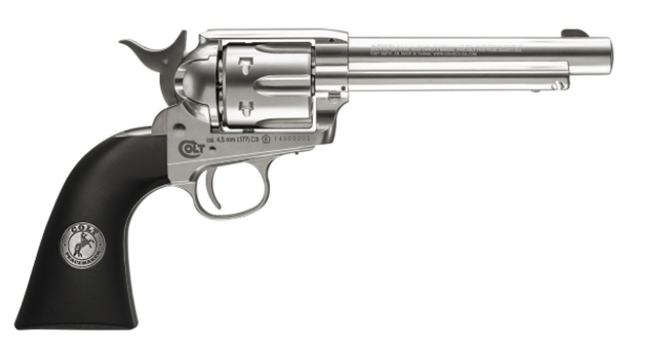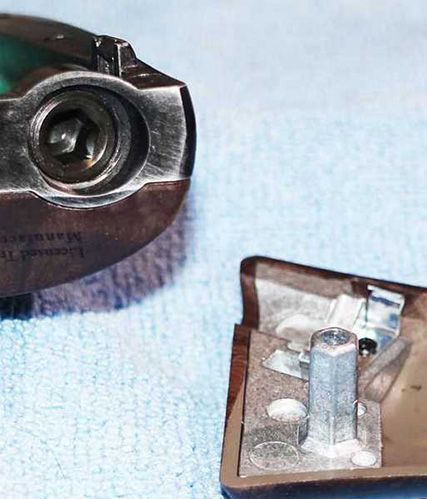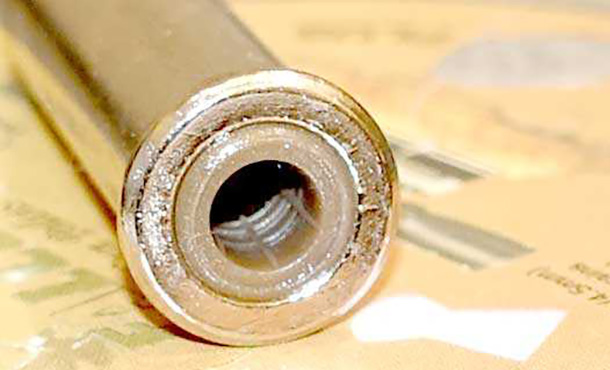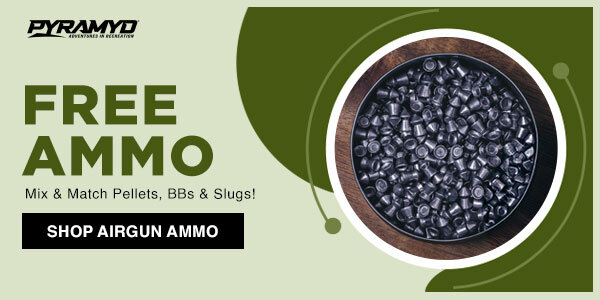
Colt Single Action Army pellet pistol.
This report covers:
- Tough
- Rifled barrel?
- Grips
- Loading
- Unloading
- Sights
- Finish
- Velocity
- Summary
Today we start looking at a type of pellet pistol I haven’t examined in a long time—the Colt SAA pellet pistol. I’ve tested several of the BB-shooting versions of this pistol but the last SAA pellet pistol I tested was the Duke back in 2015
Tough
This will be a tough report to write because I know the Colt SAA BB pistols so well. Other than its rifled barrel, this one is virtually the same.
Rifled barrel?
Yes, according to the description on the website the barrel is rifled. That’s what you expect when an air pistol is made to shoot pellets.
If this pistol was a Colt firearm I would remove the cylinder and look through the barrel to see the rifling, but the cylinder on this pistol does not come out like the cylinder of an SAA firearm.
I looked down the bore from the muzzle with a light but I could see nothing. So I did the old trick of pushing a pellet through the bore to see if the rifling engraved it. If there is rifling it’s either extremely shallow or it is unconventional rifling like polygonal rifling where there are no lands or grooves, just a polygonal barrel cross section that rotates as it goes down the bore.
The accuracy test will therefore be most interesting.
In all other ways this revolver is just like the SAA BB pistols I’ve tested several times. The most recent of those was the Engraved Peacemaker report we finished in February. But I’m going to report on this pistol as if I never saw one before.
Grips
The right grip is where the 12-gram CO2 cartridge goes, of course. It is longer than the SAA firearm grip to accommodate the CO2 cartridge. It’s the same length as the grip from an 1860 Colt Army revolver.

The wrench for the piercing bolt is in the right grip panel that is removed to load the cartridge.
I will comment that the grip panels are very tight. Maybe some newer shooters don’t remember this but I remember a time when snap-off grip panels flexed when they were held. These don’t.
Loading
This pistol uses 6 cartridges in the cylinder. Pellets are loaded into the base of each cartridge and then the cartridges are loaded into the chambers of the cylinder.

Pellets are loaded into the base of each cartridge.Those ridges aren’t rifling. They’re there to hold the pellets in place.
To load you take the safety off then pull the hammer back to half cock. Then swing the loading gate open. That frees the cylinder to rotate.
If the safety is on the hammer cannot be moved. The website says the manual is mistaken about putting the safety on before loading, but I see that the wording in the manual has been corrected.
Unloading
The cartridges are extracted by pulling back on the extractor knob that both Colt and Umarex call the ejector knob. But these cartridges fit their chambers so loosely that all you have to do is tip the revolver up and they drop right out.
Forcing cone movement
The rear of the barrel housing is spring-loaded to move into the front of each chamber of the cylinder as it comes by. The barrel is attached to it and moves too.
Sights
The SAA sights are fixed, front and rear. The front is a low rounded blade and the rear is a notch in the frame.
Finish
The pellet pistol is finished in nickel. Many buyers prefer nickel because it’s bright. I find it hard to acquire the sights against some targets, but I will do my best in the accuracy test.
Velocity
The pistol is rated to 380 f.p.s. with lead pellets. I’ll probably try it with lead-free pellets as well, just to see what’s possible.
Summary
I’ve tested this kind of pellet pistol before but it’s been quite a a while. I’m treating this one as if this is the first time I’ve seen it. Maybe because some new pellets have come to market since I last tested an SAA pellet pistol it will be.

Tom,
Could whoever wrote that it is rifled be thinking that the fluting that grabs the pellet on the individual cartridge is rifling?
Siraniko
Siraniko,
I don’t think so.
BB
BB,
I never did check the rifling, but based on these small groups I got with my 7.5″ Umarex Colt SAA, I would say this thing must be rifled. 😉
Granted, this is only at 5-meters; but these groups were shot at our old house, before we moved to the farm.
And now this revolver has been passed on to be enjoyed by my (history buff) grandson.
I never really shot any groups with it here; but I’ve used it to take down soda cans on the 15-yard range.
It’s good for 48 powerful shots; I’ve fired up to 60 on one cartridge (and those last shots were weak), but told my grandson not to exceed 48, in order to ensure he never gets a pellet lodged in the barrel.
To help him with that, I sent him exactly 48 cartridges along with the pistol. 🙂
He likes the realism of loading the cartridges into the revolver; but I told him that if he’s ever feeling lazy (as I often do), he can leave the cartridges in the pistol and just press pellets into the rear of them; once you do it a couple of times it becomes pretty easy.
Blessings to you,
dave
P.S. Those groups were NOT shot offhand; they were shot off a rest, a cat tree perch, LOL!
One more replica then. And quite aged ones. Could it be that PA want to promote sales of the kind? In any case I will keep trying to persuade Tom that testing newer models of air pistols, not only replicas, might be of interest to the readership here. Hatsan Velox comes to mind.
The mechanics of this pistol seem to be quite similar to the Barra Schofield pistol that I own. I have noticed that there is some leakage of air around the cylinder when it is fired. I would assume that that is normal and unavoidable due to the nature of the revolver design (firearm revolvers seem to do something similar also). If I fire the pistol with no pellets in it, the leakage is minimal. But when firing a pellet the leakage is noticeably stronger. It makes me wonder if there is a way to get a better seal. Perhaps some silicone grease on the rubber part of the shells, a slightly stronger spring on the barrel, or seat the pellets slightly deeper.
Elmer Fudd,
Ever seen a revolver shooter with bare hands use a two handed hold with the off hand holding around the front of the cylinder and frame. Most only do it for one shot.
Sounds like this revolver’s design tries to “seal” the front of the cylinder chamber to forcing cone by moving the barrel into that area with spring pressure. In the airgun version there is another gap at the rear of the cylinder to allow gas to escape that doesn’t happen on the firearm…since the hole in the back of the airgun brass isn’t open in a firearm cartridge unless the primer blows out.
FREE TIP: I have a S&W .44 Magnum firearm that came with the top strap drilled and tapped for various sight bases that were not filled with SOMETHING. My gunsmith filled those empty holes with set screws because the gas jets from the cylinder to forcing cone gap can do more (cutting) damage getting into those holes than on the flat surfaces.
shootski
Yes, I think you nailed it Shootski. That hole in the back of the airgun brass (actually a rubber plug with a hole in it) does seal against the transfer port. However, the cylinder does have about .035” “play” built into the mechanism. So when the gun is fired, friction between the pellet and the brass shell/barrel causes both the cylinder and the barrel to move forward a little bit, and, consequently, a gap to open up between the transfer port and the rubber plug in the back of the brass shell. A spring on the muzzle end of the barrel pushes against this forward movement of the cylinder/barrel. But that spring needs to be relatively weak so that the cylinder can easily rotate to the next ammo.
It seems to me that this design would be somewhat power limited due to the leakage. A larger caliber pellet might be one way to increase power. But I think that a slightly stronger spring might help reduce the leakage also.
I have thought I would not mind a Webley MK VI or a Gletcher Nagant, but I myself do not have a desire to own something like this.
Perhaps a bright light shining on the front of the cylinder while looking down the muzzle will reveal whether this barrel is rifled or not? I used a similar method to examine the barrel of a Gauntlet this weekend.
A couple of minor booboos.
Rifled barrel? – Last paragraph – First sentence
It (In) all other ways this revolver is just like the SAA BB pistols I’ve tested several times.
Sights – First sentence
The SAA sights and (are) fixed, front and rear.
For an Appalachian-American, I seem to be pretty picky. 😉
RR,
Fixed. Thanks,
BB
RR,
Perhaps you missed this in the section titled Rifled barrel?
“I looked down the bore from the muzzle with a light but I could see nothing.”
BB
Respectfully, perhaps if you saw nothing, and pellets show no rifling marks, the barrel actually isn’t rifled and the packaging is incorrect?
I really enjoy mine which is also the pellet version in nickel. I found the RWS Meisterkugeln shoot the best in mine with a 10 shot semi-rested group of 0.359″. The Crosman Destroyers were easily the worst at 1.014″. I tested 9 different pellets in all but the caveat is if you recall from previous similar shares, these tests were in my bedroom at a short distance of about 10 feet.
Other pellets and results:
RWS Basic 0.503
RWS Hobbys 0.793
Crosman Pointed 0.469
H&N Excite II Wadcutters 0.471
Daisy Precision Wadcutters 0.594
Crosmna Competition Wadcutters 0.849″
CPHPs 0.593
Bob
Looky there, the Excite II are probably the most economical choice for accuracy and value. Nice!
The Barra Schofield comes as a BB pistol with a smooth barrel. A rifled barrel kit is available in .177 caliber. Changing the barrel is pretty easy. I did confirm the rifling in the rifled barrel. I used my Teslong borescope which is slightly too big to fit inside a .177 barrel. But I could see the rifling by placing it close to the barrel. The attached photo appears to show 12 grooves.
I did shoot pellets through the smooth barrel before changing it to a rifled barrel. If you have the brass shells designed for pellets (which load from the rear) either the smooth or rifled barrel works for pellets. It will be interesting to see what BB finds regarding the rifling in the barrel on the Colt SAA pellet pistol.
I place some white paper near the breach and shine a high intensity light on it from the side to reflect up the barrel with most airguns. Removed the cartridges from my Fort Smith Commemorative SAA model and yes there is rifling.
It is very shallow. The lands are wide and numerous and very close together. I assume they don’t do too much to cut into a pellet and distort the edges of the head and skirt. Look more like a smooth twist with very thin grooves between the lands. Probably works well with light pellets as opposed to heavy bullets.
Straw tube inner barrels simply are not thick enough for anything deeper anyway.
A magnifier glass helps a lot.